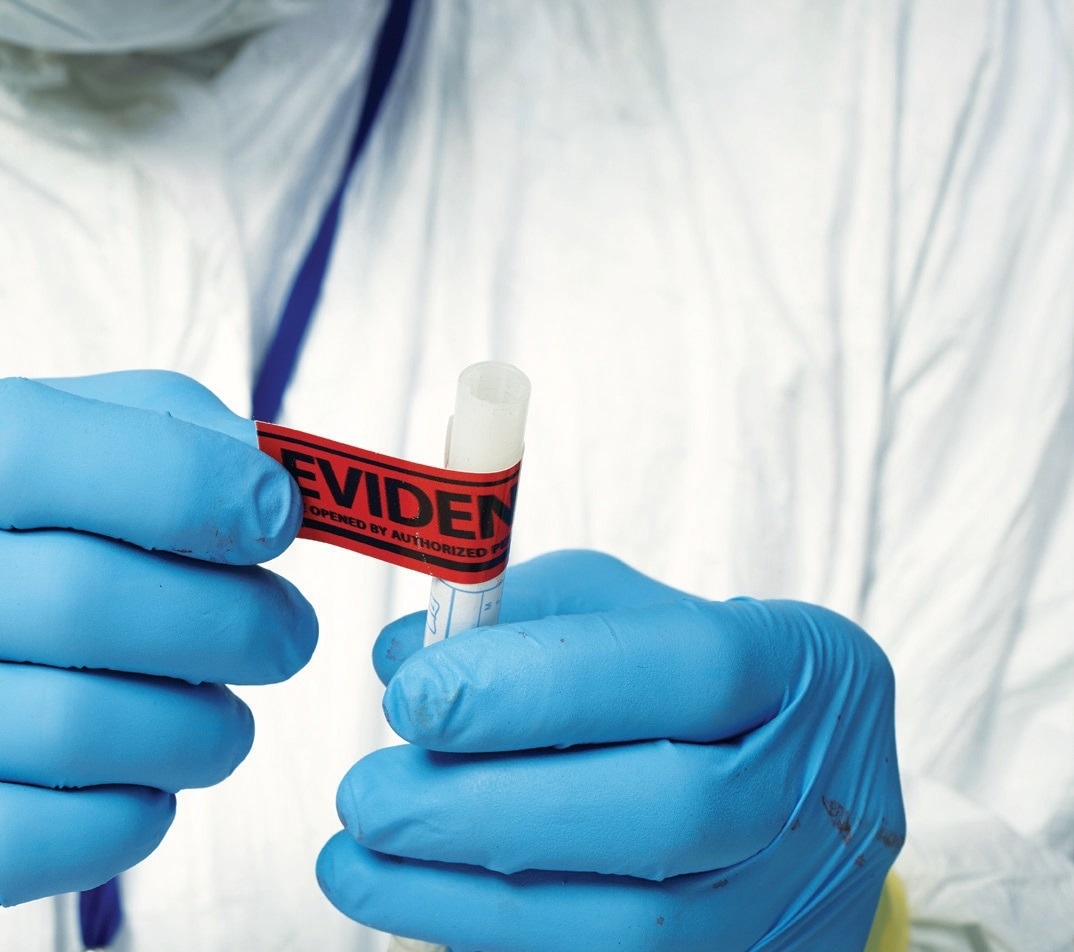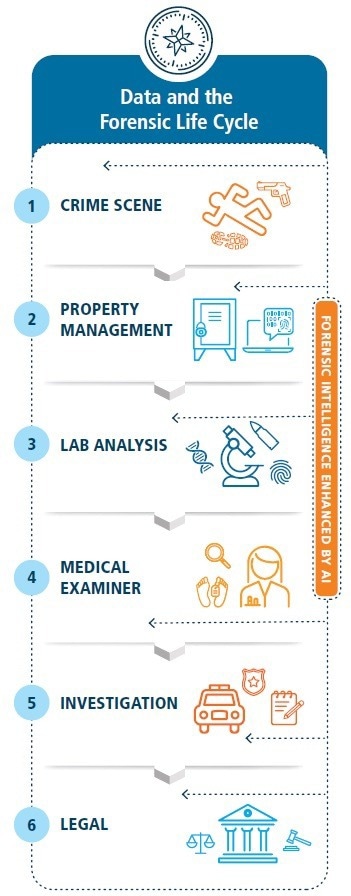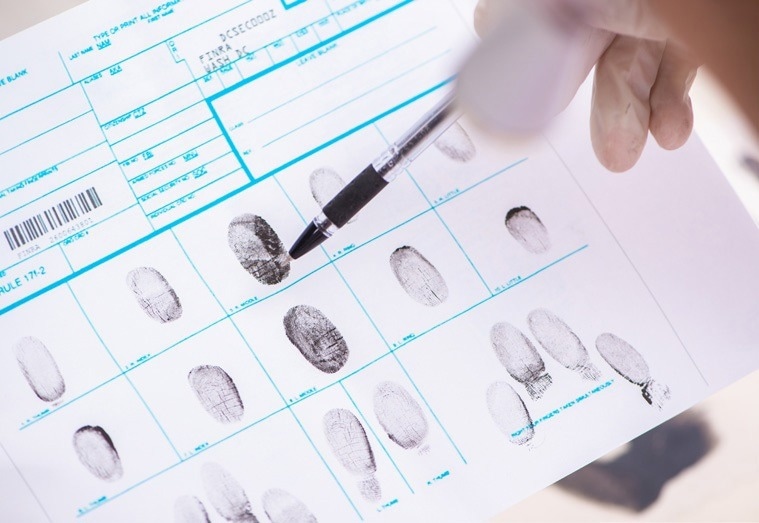Ever since the Chinese physician and judge, Song Ci, used his cutting-edge methods to investigate crimes in Hunan Province, science and crime-fighting have been inextricably intertwined for more than 18 centuries.
In present-day crime laboratories, technicians and scientists assist prosecutors and police departments and by using a wide range of disciplines, including almost every field of the physical, life, and computer sciences.

Image Credit: LabVantage Solutions, Inc.
For instance, a DNA Analyst might be attempting to locate a killer by amplifying DNA obtained from a crime scene, and a digital analyst might be looking for evidence in a computer hard drive while a toxicologist is seeking to identify a complicated designer drug used in a date-rape case.
Regardless of their position, crime lab staff now significantly rely on laboratory information management systems (LIMS) to track samples and associated data throughout the laboratory life cycle. Currently, almost all forensic laboratories have some sort of automated system in place for handling a variety of data and reports.
However, the scientific labor involved in resolving criminal cases is not limited to the lab; it starts at a crime scene and continues through the investigative process to the courtroom and beyond; sometimes, this process can last years.
Since DNA evidence has become a major factor in determining guilt or innocence, the scientific chain of evidentiary custody in cold cases can now last for decades.
The forensic information management system (FIMS), which has developed over the last two decades to handle the special requirements of the forensic laboratory and all the numerous components of law enforcement who rely on the lab, has grown along with new techniques for solving crimes.
The evolution of FIMS
As stated above, the collection and analysis of evidence is not limited to the lab. Therefore the term "LIMS" does not capture the totallity of what law enforcement organization need. A btter term is "FIMS" Forensic Information Management System. Everybody involved can gain from a FIMS to maintain an unquestionable electronic chain of evidence custody from the time police arrive at the location to the day of either conviction or exoneration of the suspect(s), regardless of the type of crime that has been committed and how the investigation develops. Some organizations start entering data into an electronic system as soon as it is gathered.
A thorough investigation of the murder site or a straightforward traffic stop could serve as the point of collection. The same fundamental data will be gathered in both scenarios, but a crime scene unit will gather much more data. How the scene was handled, for example, the methods employed to create latent prints could be considered additional information. The detective could also learn more about the climate or the preservation techniques used at the spot.In both situations, the evidence will be recorded, and the chain of custody must begin right away.
Protecting the chain of custody
Regardless of the kind or seriousness of a crime, evidence is essential to a case. At each step in the process – as police specialists collect evidence and the judiciary begins to present its case against a suspected perpetrator – it is essential that evidence be correctly handled and the chain of custody rigorously maintained. This includes transfers from one person to another as well as to and from secure areas.

Image Credit: LabVantage Solutions, Inc.
Crime scene
The journey of the data starts with a crime. All pertinent information must be gathered, entered in real-time, and handled as the case develops. This includes DNA samples, phone records, law enforcement statements, a chain of custody, and more.
Property management
To preserve the chain of custody, evidence is kept in a monitored, controlled setting. There must be tracking of disposition requests, evidence viewings, and more.
Lab analysis
Forensic laboratory examiners analyze the data, correlate it to databases like the National Integrated Ballistic Information Network (NIBIN), the Automated Fingerprint Identification System (AFIS), and the Combined DNA Index System (CODIS), and present their results. To facilitate ISO 17025 compliance, they require quality assurance tools.
Latent print examiners working in a crime lab require the capacity to quickly compare impressions and persons involved. They may also require blind verification of their findings as well as a method to track and manage inconsistent results.
The ability to work with liquid handlers, export and import quantification and typing data, perform calculations, manage master mixes, and create a profile data file that can be uploaded to the FBI’s Combined DNA Index System (CODIS) are all features that DNA examiners want to make sure their FIMS can provide.
Toxicologist will want the ability to work as a team throughout the analysis of samples from various cases over numerous different batches.
Medical examiner
With their studies of human remains and conclusions regarding the cause of death, forensics experts and medical examiners contribute to the volume of data.
Investigation
Detective notes, witness interviews, social media profiles, and other types of data are all produced with the help of the investigation’s leads. This information is included in the forensic record.
Legal
The information that began with a crime continues through the legal process. It is important to have enough proof to indict a suspect and sufficient evidence to back up a conviction or clear an accused person. Status updates and reports must also be available to lawyers and other legal professionals.
The problem with point solutions
While not all law enforcement agencies have a laboratory, practically all of them have property warehouses and must meet the requirements to ensure that the chain of custody is unquestionable and that any item can be retrieved at a moment’s notice.
It is also necessary to facilitate several types of disposition actions, including destruction, donations, conversion to police use, return to owner, and auctioning, toward the conclusion of the criminal investigation and prosecution process.
As storage facilities can rapidly fill up, and it can be expensive and time-consuming to acquire new facilities that can accommodate evidence, disposition is crucial.
When investigations are concluded, or the statute of limitations has passed, the system should be able to immediately contact detectives and request their approval to manage the disposition process.
The difficulties at each stage of the process have been addressed with a variety of solutions, but what has been absent is an integrated system that works flawlessly on every web browser and complies with the HTML5 standard, which will soon be required by US law enforcement authorities.
As recently emphasized in a Deloitte analysis on the future of policing, more and more, “innovation tends to work best when all these forms come together to enable police and law enforcement agencies to have greater insight and impact than ever before. The innovations that are shaping the future of law enforcement begin with emerging technologies that support new concepts of operations….”
Faster results — From crime scene to courtroom
LabVantage has created the LabVantage Forensic NavigatorTM, a comprehensive platform that covers the entire forensic life cycle, moving seamlessly from the crime scene to the courtroom.
This platform was created in response to the growing demand for law enforcement agencies and related parties to have access to an integrated FIMS that can scale with them into the future.

Image Credit: LabVantage Solutions, Inc.
A forensic navigator is a cutting-edge tool that connects investigative workflows by utilizing forensic information and predictive analytics through an optional artificial intelligence (AI) capability. It works natively on the most recent HTML5 standard.
Forensic Navigator offers a wide range of advantages that work together to produce speedier investigations at a reduced cost, as opposed to the point solutions that some law enforcement agencies have pieced together to provide some semblance of consistency across the investigative process. Several of the strong differentiators are as follows:
- A single, integrated platform
- Web portal for submitters and legal staff
- Supports ISO 17025- and CALEA compliance
- Offers a go-live plan
- Encompasses the complete forensic life cycle
- Configurable platform eliminates customization
- Flexibility to use as SaaS
- Best-in-class cybersecurity protection
- Developed by a trusted provider with decades of experience in technology solutions
- Browser agnostic
- Spontaneously runs on HTML5 and other essential industry technologies
- Forensic intelligence (software improves predictive analysis using AI capabilities and provides greater perspectives from investigative data)
From collection to science
Users may go from forensic data gathering to forensic data science with the help of LabVantage Forensic Navigator’s integrated platform and tools. Due to the instrument and system connections, less human effort is required, which minimizes data entry errors, speeds up data entry, and lowers resource costs for both system users and administrators.
Implement a frictionless interchange of thoughts from one end of the law enforcement agency to the other to speed up investigations and solve crimes more quickly. Forensic Navigator is configurable and can be utilized concurrently inside or outside the office or from anywhere else remotely.
Forensic Navigator, as opposed to pointing solution systems, enables the use of historical LIMS data for the benefit of the entire organization, fostering deeper statistical analysis, cutting-edge insights, and dynamic intelligence.
Forensic Navigator, which was created and tested to meet the highest cybersecurity standards, encrypts all data stored on cloud servers and VPN tunnels connected to cloud-hosted and SaaS-based deployments, allowing the storage of all evidence securely in one location.
A single platform that does it all
LabVantage Forensic Navigator assists law enforcement agencies of all sizes in accelerating the worldwide investigative process to enhance the administration of justice for everybody.
Our platform creates seamless flows of information, supporting quality management and forensic intelligence through improved investigative insights and AI capabilities. It also captures and tracks leads, conducts lab tests, compiles cases, and conducts court proceedings.
When one system can do it all, there is no need to buy, implement, connect, test, and learn how other systems works. Beyond the standard laboratory LIMS, Forensic Navigator offers additional features. From a secure web-based portal, it allows law enforcement to enter data in real-time, request examinations, and check the status.
The analytical layer provided by available AI is necessary to gain insight from the enormous volume of forensic data.
Regardless of the position within the forensic life cycle, Forensic Navigator offers the resources and access required to stay informed and make important choices. Users can trust LabVantage’s Forensic Navigator to help them expedite analysis of evidence in a case and trust in the outcome of the investigation.
It is the only solution for forensic intelligence from the site of the crime to the courtroom, speeding up the investigation by organizing, connecting, and analyzing every element of a criminal case.
About LabVantage Solutions
LabVantage Solutions, Inc. is the leading global laboratory informatics provider. Our industry-leading LIMS platform, including ELN, LES, and SDMS, and world-class services are the result of nearly 40 years of experience in laboratory informatics. LabVantage offers a comprehensive portfolio of products and services that enable companies to innovate faster in the R&D cycle, improve manufactured product quality, achieve accurate recordkeeping and data integrity, and comply with regulatory requirements.
LabVantage is a highly configurable, web-based LIMS platform that powers hundreds of laboratories globally, large and small. Built on a platform that is widely recognized as the best in the industry, LabVantage can support hundreds of concurrent users as well as interface with instruments and other enterprise systems. It is the best choice for industries ranging from pharmaceuticals and consumer goods to molecular diagnostics and bio banking. LabVantage domain experts advise customers on best practices and maximize their ROIs by optimizing LIMS implementation with a rapid and successful deployment.
Sponsored Content Policy: News-Medical.net publishes articles and related content that may be derived from sources where we have existing commercial relationships, provided such content adds value to the core editorial ethos of News-Medical.Net which is to educate and inform site visitors interested in medical research, science, medical devices and treatments.